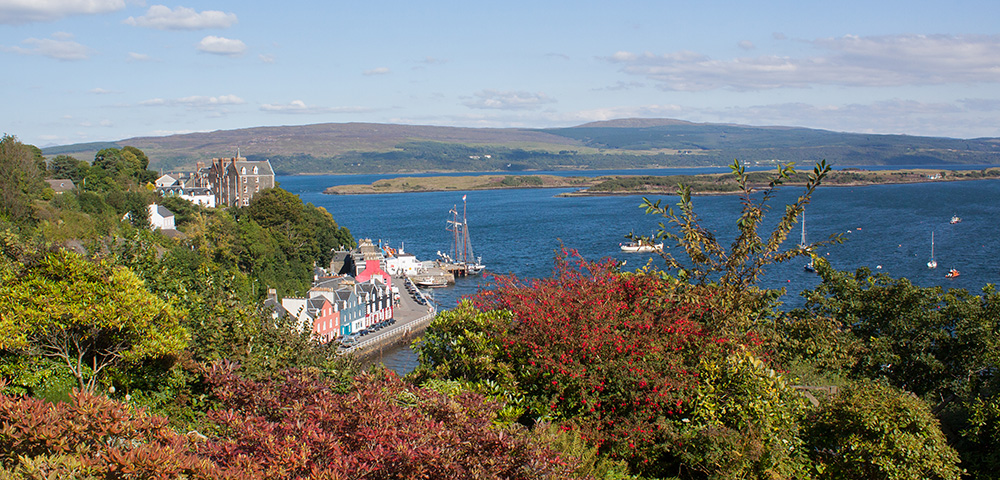
A brief guide for anyone considering or actually visiting the Isle Of Mull.
I'll be adding content to it over time, and if there is anything anyone would like me to add, please let me know via an email.
Getting To Mull
Mull is the second largest of the islands that make up the Inner Hebrides, off the West Coast of Scotland.
It is north-west of Glasgow, and south of Skye. It's pretty large, so you won't miss it on a map.
There are 3 ferry crossings to Mull.
- 1. Oban - Craignure
- 2. Lochaline - Fishnish
- 3. Kilchoan - Tobermory
Only the Oban to Craignure ferry booking can be made in advance of a trip.
During the summer months, it is wise to book well in advance of your trip, as they fill up quickly.
The other two crossings are simply a case of arriving at the ferry terminal and waiting for a place on the ferry. These cannot be booked in advance.
Driving On Mull
Single track roads have numerous passing places along them.
These are usually marked with a black and white striped pole.
They're there to allow vehicles to pass each other.
Use a bit of common sense to determine the best passing place to use when allowing vehicles to pass each other.
Be prepared to reverse back if you've missed one and it is much closer to you than the passing place behind the other driver.
If the passing place is on the left, pull into it.
If the passing place is on the right, park on the left next to it. Do not go right into the space, as this can cause confusion and accidents.
Be courteous. Thank the other driver for allowing you to pass. Wave, smile, it doesn't cost anything and is appreciated.
If another driver catches you up, chances are, they would like to get past you.
So let them overtake.
The passing places are for overtaking too.
If the next passing place is on your left, pull into it, indicate left and allow the vehicle to overtake.
If the next passing place is on your right, park up on the left and indicate left, and allow the vehicle to overtake.
The roads on Mull are dangerous and littered with potential dangers.
There are sheep that are seemingly suicidal, and will walk out in front of you at the last second.
Deer and larger livestock (hairy coos and the like) that stray into the roads.
As with much of the UK, the surface of the road can be strewn with pot-holes.
And the edges of the roads can be steep, so be careful when going over the side of the road.
All these dangers can be dealt with more easily if you're driving at a sensible speed for the conditions.
And when driving alongside lochs, be aware that otters might dart out in front of you. They don't adhere to the Green Cross Code, so by going more slowly you have more of a chance of avoiding them.
Watching Wildlife
If you've spotted wildlife or noticed other people watching something, be quiet if you decide to stop to watch too.
Talking loudly or slamming the doors on your vehicle might scare the wildlife away.
Most wildlife subjects are sensitive to people approaching them, unless you have learned the necessary field-craft to approach without disturbance.
So hold back from rushing over.
Use binoculars or a scope.
Don't assume that because other people are closer than you, that it's safe for you to go join them. They might have spent a considerable amount of time approaching the subject, and won't be too happy if you stroll over and scare the wildlife away.
If possible, park somewhere off the road that isn't going to hold up other motorists.
Try to avoid parking in passing places. If you do linger in one, park at the very end of it, so as to allow vehicles to still get by.
And don't wait too long.
Be mindful that the grassy area that looks perfect might be more of a marsh, and you might get stuck!
Watch the edges of the road as you park, as there can be quite a drop.
Respect Residents
While I no longer live on Mull, during my time there as a resident, I made many friends, and many still live there. And increasingly I'm hearing horror stories from them about how they've been treated or spoken to, by visitors. Especially from wildlife-watchers.
People have lived on Mull for centuries now, and the wildlife has become used to people being around.
I blame social media for a lot of the grief that the residents endure. Facebook groups are overflowing with people with far too much opinion on things they have little or no knowledge or experience of.
Before you decide to intervene with something you believe to be wrong, consider a few things.
- Would you like a stranger approaching you in your own garden and telling you to be quiet?
- Would you like someone telling you that you can no longer walk your dog in an area you have been walking it for years?
- Would you like to be sworn at for going about your daily life?
- Would you like someone pointing a camera into your garden? Or have someone sitting on your garden wall?
These are just a snippet of some of the anti-social behaviour that some of my friends on Mull have to endure, and not just occasionally, we're talking sometimes weekly.
Respecting the wildlife on Mull (and everywhere else) is important, but so is respecting the residents who have to live and work on the island.

